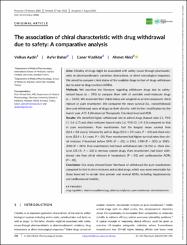| dc.contributor.author | Aydın, Volkan | |
| dc.contributor.author | Bahar, Ayfer | |
| dc.contributor.author | Vızdıklar, Caner | |
| dc.contributor.author | Akıcı, Ahmet | |
| dc.date.accessioned | 2023-01-12T11:55:46Z | |
| dc.date.available | 2023-01-12T11:55:46Z | |
| dc.date.issued | 2023 | en_US |
| dc.identifier.citation | Aydın, V., Bahar, A., Vızdıklar, C. ve Akıcı, A. (2023). The association of chiral characteristic with drug withdrawal due to safety: A comparative analysis. British Journal of Clinical Pharmacology, 89(1), 290-298. https://dx.doi.org/10.1111/bcp.15486 | en_US |
| dc.identifier.issn | 0306-5251 | |
| dc.identifier.issn | 1365-2125 | |
| dc.identifier.uri | https://dx.doi.org/10.1111/bcp.15486 | |
| dc.identifier.uri | https://hdl.handle.net/20.500.12511/10297 | |
| dc.description.abstract | Aims Chirality of drugs might be associated with safety issues through pharmacokinetic or pharmacodynamic variations, interactions, or direct toxicological responses. We aimed to compare chiral status of the available drugs to that of drugs withdrawn due to adverse drug reactions (ADRs). Methods We searched the literature regarding withdrawn drugs due to safety-related issues (n = 391) to compare them with all available small-molecule drugs (n = 1633). We examined their chiral status and assigned as achiral compound, chiral mixture or pure enantiomer. We compared the mean survival (i.e., nonwithdrawal) time and withdrawal rates of drugs by their chirality, with further stratification by the launch year, ATC-1 (Anatomical Therapeutic Chemical) level and ADR. Results We identified higher withdrawal rate in achiral drugs (hazard ratio 2.1, 95% CI: 1.6-2.7) and chiral mixtures (hazard ratio 2.6, 95% CI: 1.9-3.5) compared to that in pure enantiomers. Pure enantiomers had the longest mean survival time (62.4 +/- 0.8 years), followed by achiral drugs (55.4 +/- 0.9 years, P < .01) and chiral mixtures (52.4 +/- 1.4 years, P < .01). Pure enantiomers had higher survival rates than chiral mixtures if launched before 1941 (P = .02), in 1961-1980 (P < .001) or 1981-2000 (P < .001). Pure enantiomers had lower withdrawal rate (18.2%) vs. chiral mixtures (35.1%, P = .02) in nervous system drugs. Pure enantiomers had lower withdrawal rate than chiral mixtures in hepatotoxic (P < .01) and cardiovascular ADRs (P < .01). Conclusion Our study showed lower likelihood of withdrawal for pure enantiomers compared to that in chiral mixtures and achiral drugs, which was more remarkable for those launched in certain time periods and several ADRs, including hepatotoxicity and cardiovascular toxicity. | en_US |
| dc.language.iso | eng | en_US |
| dc.publisher | Wiley | en_US |
| dc.rights | info:eu-repo/semantics/openAccess | en_US |
| dc.subject | Drug Regulation | en_US |
| dc.subject | Pharmacoepidemiology | en_US |
| dc.subject | Pharmacovigilance | en_US |
| dc.subject | Pure Enantiomer | en_US |
| dc.subject | Stereoisomerism | en_US |
| dc.title | The association of chiral characteristic with drug withdrawal due to safety: A comparative analysis | en_US |
| dc.type | article | en_US |
| dc.relation.ispartof | British Journal of Clinical Pharmacology | en_US |
| dc.department | İstanbul Medipol Üniversitesi, Uluslararası Tıp Fakültesi, Dahili Tıp Bilimleri Bölümü, Tıbbi Farmakoloji Ana Bilim Dalı | en_US |
| dc.identifier.volume | 89 | en_US |
| dc.identifier.issue | 1 | en_US |
| dc.identifier.startpage | 290 | en_US |
| dc.identifier.endpage | 298 | en_US |
| dc.relation.publicationcategory | Makale - Uluslararası Hakemli Dergi - Kurum Öğretim Elemanı | en_US |
| dc.identifier.doi | 10.1111/bcp.15486 | en_US |
| dc.institutionauthor | Aydın, Volkan | |
| dc.identifier.wosquality | Q2 | en_US |
| dc.identifier.wos | 000844722500001 | en_US |
| dc.identifier.scopus | 2-s2.0-85136804608 | en_US |
| dc.identifier.pmid | 35942905 | en_US |
| dc.identifier.scopusquality | Q1 | en_US |


















